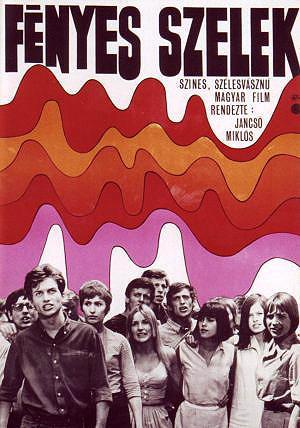Four Jancsós today: two winners, two losers.
And a rousing conference with his widow and long term editor, Zsuzsa Csákány.

1. 9:30AM
Fényes Szélek (Venti Lucenti, or The Confrontation, 1968. Color, 78"
Loser, with modern day setting. 1947. The Communist party has just come to power. Young people in shirtsleeves. Okay, kids -- lets all hold hands, line up, and recite the catechism. Lots of repetitious political declamation. Some horses. Some nudity. Nothing new. Unexceptional, in fact --
Very Boring all the way.
2. 11:30, Szerelmes Elektra(Elektra in Love), 1974, color, his First color film, and the first to use song and dance extensively.

Rousing horse opera with Mari Tőröcsik as Elektra and strong Cserhalmi György as Orestes. Madaras with shaven head as the stumpy king. Great choruses and dancing. Big crowd scenes and elaborate dances. Lots of nudity, painted nude bodies. Everything on the move all the way. The camera never stops moving snd the people within the frame are always moving. Tőröcsik no longer cute as she was in her early films. Her first mature role. Overall rouser with strong music and lots of fogged out misty scenes. It opened with 26 horses in long shot galloping through the mist screen right. Had the same young guy as in the earlier modern film. This was the first of the visually elaborate loaded "horse operas" that made Jancsó famous. Forget the logic -- just let it wash over you ....
3. 13:45: Elmontak-e -- (Did I ever tell you about this?)- 1996, 48 astounding minutes. Tremendous breathtaking History of antisemitism and the Holocaust in Hungary from Horty's admiration of Schiklgruber (sic) to the Gas chambers, deportations in cattle cars, and then the post war aftermath. Jaw dropper with Jancsó as narrator. Feels like a feature length film. Jancsó tells the new generation of Hungarians a story they must be told before it is forgotten.
4. Csend és kiáltás (silence and outcry), b/w 1967, 76" -- no horses or crowd scenes -- little music. Zoltan Latinovits, Tőröcsik Mari. Andrea Drahota and Kovacs Andràs are straight from the success of istvan Gaál's Sodrásban, which made them overnight stars -- Butor in his usual role as a towering armed Soldier carrying out his orders -- Stovky Jozsef Madaras is in there as usual in all of Jancso's sixties films. Spare dialog, mostly terse orders dealt out by Latinovits, a military officer. At the end he offers Kovacs a pistol with one bullet to commit honorable suicide, but instead the prisoner turns the gun on Zoltan and shoots him out of frame. The film ends with a freeze frame on the shooter.
Not top notch Jancsó by any stretch of the imagination -- more like an exercise in bare bones style all set in a remote village in the country. Very theatrical as if on an outdoor stage.
Body count on Jancsó is now thirteen films down with six more to go.
The last film of the day was a very good one from Jasmila Žbanić.
"For those who can tell no tales", Bosnia, Australia, 2013, 72 min.
With indirectly references to "Bridge on the Drina" by Nobel Prize author Ivo Andrić. Striking visuals of the bridge with its nine arches reflected in the waters. An Australian tourist visits The city of Vishegrad in Bosnia and finds out things about recent history there she would rather not have known setting off a painful personal investigation. The city was thoroughly ethnically cleansed in 1992.- A strong followup to Grbavica, viewed yesterday. Long interview with Žbanić to follow. She is one of the featured directors at Bergamo this year.